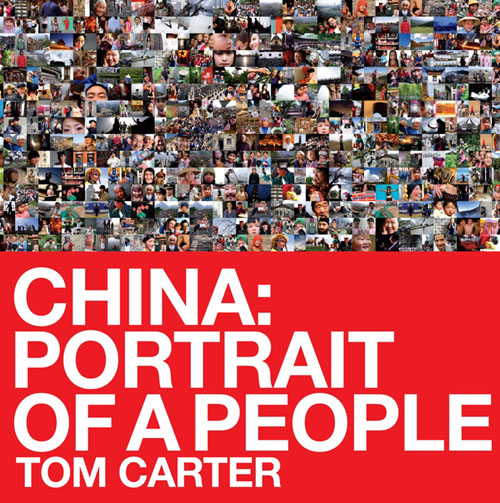Snapshot of a country
一个美国摄影师镜头下的中国
|
|
By John Sexton
China.org.cn staff reporter

|
| Like countless other young people, Tom Carter came to China to teach English and go traveling. But he traveled further, for longer, visiting all 33 of China's provinces twice in two years. He took more pictures than most. Crucially, he took the pictures that everyone else wanted to. |
像其他无数年轻人一样,汤姆·卡特在中国教授英语的同时游遍大江南北。但是他比一般人旅行地更为深入和持久,他在两年的时间内两次走遍中国33个省市。他拍摄了许许多多多的照片。关键的是,他拍摄了每个人都想拍摄的照片。 |
| The result, his book China: Portrait of a People, is a snapshot of an entire country in a time of great change; a truthful and touching portrayal of the Chinese people in all their variety, charm and earthiness. As such, even if it does not turn out a best-seller, it will have lasting value as a social document. This isn't a coffee table book of the Great Wall or the quintessentially Chinese landscapes of Guilin. It isn't a travel book either, although it may well inspire many to come see China for themselves. |
旅行的成果便是他出版了一本摄影画册《中国:一个民族的画像》,拍摄下处于巨变时代中的中国,忠实而感人地记录了中国人民的多彩风姿、无穷魅力和质朴纯真。严格说来,尽管这本摄影画册不能成为一本畅销书,但它作为社会的记录具有持久的价值。它不是关于长城或典型的桂林风景的休闲读物,也不是旅游指南,但是它完全可以引发人们亲自来到中国看一看的兴趣。 |
| What's more, Carter has shown us just how easy it is. Just get on the bus, Gus. Buy a ticket, ride from town to town, chat to people and take their picture. I have traveled many of same roads in the same way and this photo-book captures the feel, the color, the smell of China better than most others I have seen. |
此外,卡特向我们展示了在中国旅游是如此简单。只要坐上一辆公交车,买一张票,穿梭于各个城市之间,与当地人交谈,给他们拍照。我曾经用同样的方式游览过许多同样的地方,这本图册比我所见过的其他同类书籍能够更好地捕捉到属于中国的感觉、色彩和气息。 |
| His subjects are casual, un-posed, unrehearsed. He manages to achieve an extraordinary intimacy, not just with cute kids and young women, but with worshippers at a mosque, with a miner caked in coal dust changing his clothes at the end of a shift. He clearly must have considerable charm to have achieved these candid snaps of people who are normally shy of having their picture taken. But as he says, and people who travel the country soon find out, ordinary Chinese people are extraordinarily warm with foreigners. |
他的拍摄主题随意而不做作,也不做任何预先计划。不论是和可爱的孩子还是年轻的女士,不论是和清真寺的祷告者还是轮班前更换衣服的满身矿灰的矿工,卡特在拍摄照片时都能够和他们形成一种舒适的默契。显然,他必须具有很大的亲和力才能为那些通常因为害羞而不愿拍照的人拍摄照片。但是据他自己所说,在中国旅游的外国人很快会发现,这里的普通老百姓对外国人特别热情。 |
| Above all, Carter's photographs depict the diversity of China, from chic young socialites to toothless derelicts, from wrestlers to karaoke girls. An let's not forget that this is a country of 56 official nationalities (and several more that, back in the 1950s, failed to make their case to officials overwhelmed with applications for recognition); Carter captures them, not dressed up for tourists, but still, in surprising numbers, wearing traditional dress. |
最重要的是,卡特的照片描述了中国的多样性,从时髦而年轻的社会名流到没有牙齿的流浪汉,从摔跤手到歌厅女郎。我们不要忘记这是一个由56个民族组成的国家 (比56个还要多,早在上世纪50年代,有几个少数民族没能向政府机构申请获得认可),卡特拍摄的不是为了游客而身着盛装的少数民族,而是许许多多穿着传统服饰的少数民族。 |
| As Carter put it, during his two years on the road, his camera became an extension of his hand. And it is such a small, insignificant machine – not a digital SLR of the sort used by professionals. Why would he need one of those? These are not arty photographs. For the most part they are the sorts of snaps you could find in a family album. But this is the family album of a nation, the largest on earth. |
正如卡特所说的,在旅行途中的两年时间里,相机成为他双手的延伸。他使用的是一个小巧普通的照相机,并不是专业人士所用的单反相机。他觉得不需要用那样的相机来拍摄,因为他拍的不是艺术照。他拍的大部分照片是你能够在一本家庭相册中找到的那种照片,只不过他拍的是一个国家的家庭相册,恐怕是地球上最大的家庭相册了。
|
|
|
|
|

